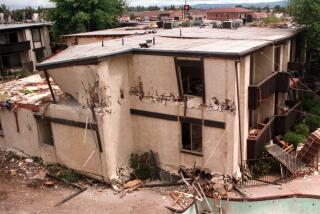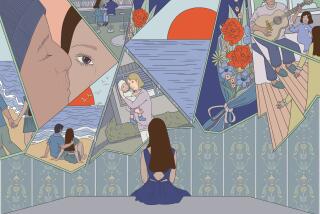John Basilone’s last battle
(Sunday’s episode of “The Pacific” — the eighth of the 10-part HBO miniseries — depicted the death of Congressional Medal of Honor recipient John Basilone during the first day of fighting on Iwo Jima. William Lansford, a Marine and Angeleno, also fought that day in Iwo Jima and recalls his friendship with the famous Marine gunnery sergeant and his last day.)
FOR THE RECORD:
John Basilone: An article in Monday’s Calendar section about John Basilone, whose death on Iwo Jima was marked on the HBO series “The Pacific,” described him as a Congressional Medal of Honor recipient. The medal, though authorized by Congress, is properly referred to as the Medal of Honor. —
In late 1944, after two years in the Pacific as a Marine with Carlson’s Raiders, I rotated stateside and received a 30-day furlough. I was supposed to rest, visit my family and enjoy life among civilians, but none of it really worked.
Unable to adjust to the complexities of wartime civilian life, I lied to my parents, saying my leave was up, and boarded a bus for Camp Pendleton with a week left of my furlough.
In Pendleton I reported and was assigned to Company C, 27th Regiment of the newly formed 5th Division, but being early, I was told I’d find the area deserted. They were right. The new barracks stood empty, the bunks had no mattresses, the rifle racks were bare, the empty halls echoing.
Outside again, I was surprised to see a young Marine smiling at me. He wore khaki, with sergeant’s stripes, and in no way resembled the muscular giant depicted in oils on a recent cover of Collier’s magazine. Actually, he looked much like any other Marine, but what caught my eye was the tiny blue ribbon spangled with white stars pinned over his other ribbons. It was, unmistakably, the Congressional Medal of Honor and the smiling guy was John Basilone.
Serving with Basilone was a brief but golden period of the war for me. He never barked like the other gunnery sergeants but ruled like a wiser, older brother looking after his younger siblings, with humor and a style all his own. Under the hot California sun, with our faces stuck in the dust of Camp Pendleton, he could pick up a draggy machine gun drill with “Awright, ya goldbricks. Ya cut the time on settin’ them guns up or don’t expect no liberty come Friday!” And we did it because we knew he was the best machine gunner in the Corps and we wanted to be like him.
Basilone did more than train the men. He taught our recruits the meaning of esprit de corps, and in those of us who had fought, he rekindled a willingness to fight again. His simplicity, his cheerfulness, his grasp of human nature — the charm and easy grace with which he carried his honors — gave us not only confidence but pride. We were “Basilone’s boys” and were envied for it throughout the division.
Our weekend hangout in L.A. was the Biltmore Hotel, where we took over an entire floor. Starting Friday evening, Basilone played and whooped it up with the rest of us until the last hours of Sunday night when we’d all crawl back to our transportation points and head for Camp Pendleton in a rush resembling a Roman chariot race, for at reveille on Monday, John expected us to toe the line, stone sober and ready for duty. We had chased girls and swilled rum and Coca-Cola all weekend, but until Friday it would be “Prepare for gun drill!,” “Ready, Sarge” and “On this line, action!” with Basilone’s keen eye on you making sure you didn’t screw up.
Early that summer of 1944 the fun ended. Our division had been ordered to Hawaii. There we began practicing landings on “Island X.” It was clear that we would soon be taking the fight to the enemy.
Some time back, I’d been promoted to sergeant and transferred to regimental headquarters as an intelligence noncom, so I was no longer one of Basilone’s boys and I missed that. I visited Basilone in January 1945, only days before we were to ship out. I wanted to say goodbye to him and the guys, for we wouldn’t be sailing together.
As I approached their tent area I could see the whole goofy crew giving one another haircuts with the company tools. John, his arms covered with hair, stood back surveying a perfectly grotesque job he’d just performed on another guy.
“Not bad,” he said. “Mohawk style — oughta scare the hell outta some poor Jap.”
“It scares me,” I said, pulling off Basilone’s cap. The handsome John was clipped bald as a brass ball.
He grinned. “What d’ya think?” Then, growing serious, “It’ll be cleaner. There’s no barber shops on Iwo Jima.”
The words echoed in my ears long after I’d left him. Iwo Jima. So that was “Island X.” Then I couldn’t help thinking: Shortly before leaving Pendleton, John had married Sgt. Lena Riggi, a pretty female Marine. So why wasn’t he back in Pendleton? His answer had always been the same: “I’m staying with my boys. They need me.” Perhaps it was the only answer that mattered.
On the morning of Feb. 19, 1945, we hit Red Beach on Iwo and started climbing its black sides under a storm of enemy mortars and artillery. Basilone had landed one wave earlier.
Having assaulted a pillbox on the beach, Basilone gathered several Marines and left them to hold while he went back for more men and weapons.
On his way, Basilone spotted three Sherman tanks struggling up the beach under heavy fire. Knowing their value for knocking out bunkers, Basilone began guiding the tanks and pointing out targets while completely exposed.
Once on high ground, Basilone resumed rounding up troops for the assault team he had started building. To do this he’d have to recross the steep volcanic beach where many Marines were still pinned down by the enemy’s relentless shelling and well-camouflaged pillboxes.
It was almost noon, and throughout the battle Basilone had risked his life repeatedly. It seemed nothing could touch him.
Many men have said they saw John Basilone fall on the beach, which he did not. One said Basilone’s legs were blown off by a mine. Several claim they heard Basilone’s final words, and one said Basilone begged to be put out of his misery with his own pistol. It’s all fiction.
The most credible eyewitness is Roy Elsner — the headquarters cook who had watched our machine-gun drills back in Pendleton and knew Basilone by sight. He said that when he and some buddies were hunting for their headquarters: “A few hundred yards from Motoyama Field No. 1 we heard an explosion, which caused us to look [toward the field]. We saw Basilone and the three guys who were with him fall.”
Some time after noon I came across a group of blackened bodies on the edge of Motoyama Airfield No. 1. Company C was advancing half a mile ahead, sweeping the flat field clean, when one of the dead caught my eye. He was a thin, pallid kid. His helmet was half off, and he lay face up, arched over his combat pack, with his jacket torn back and his mouth open. I vaguely recognized someone I had known in that lean, lifeless face beneath its dusty stubble of hair.
Someone said, “That’s Basilone.”
I walked around and asked, “Is this Basilone?”
A guy I knew said, “Yeah. He was briefing his guys when a mortar scored a direct hit. It killed them all.”
I sat and studied the dead man closely, but I didn’t touch him. The shell had landed at his feet, sending shrapnel into his groin, neck and left arm. He looked incredibly thin, like an undernourished kid, with his hands on his stomach as though it hurt. This was the hero of Guadalcanal, the joy of a nation, the pride of the Marines and my friend, John Basilone.
More to Read
The complete guide to home viewing
Get Screen Gab for everything about the TV shows and streaming movies everyone’s talking about.
You may occasionally receive promotional content from the Los Angeles Times.






